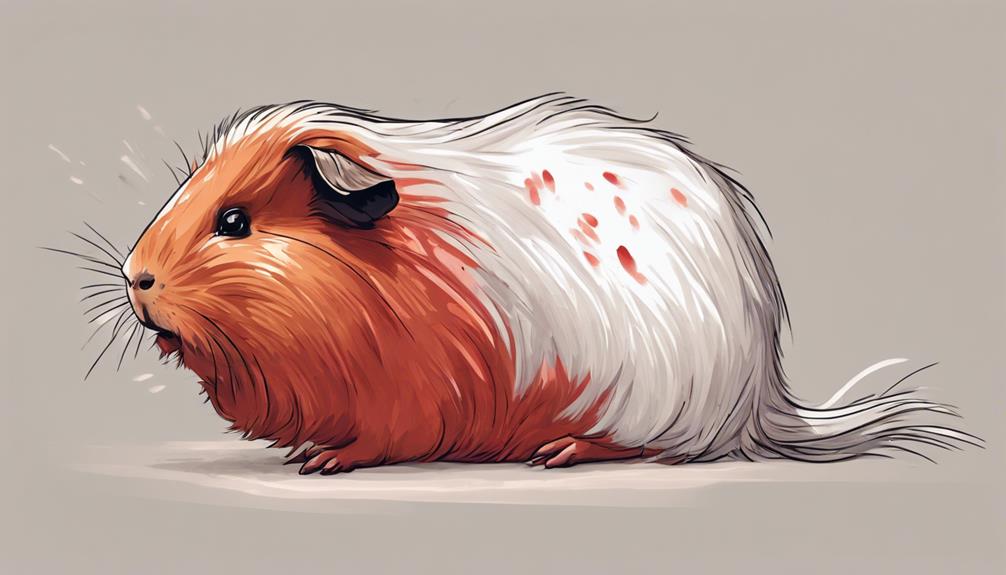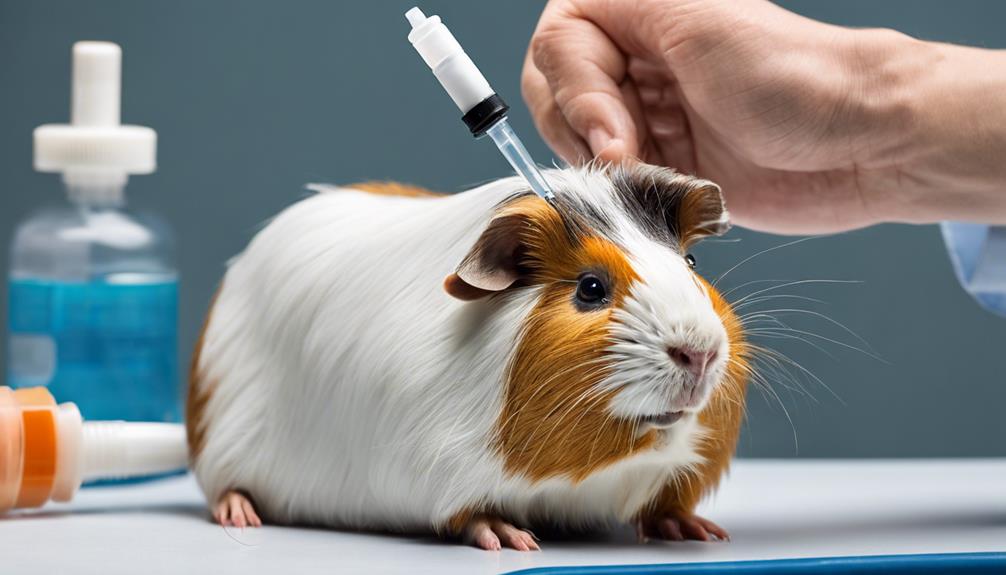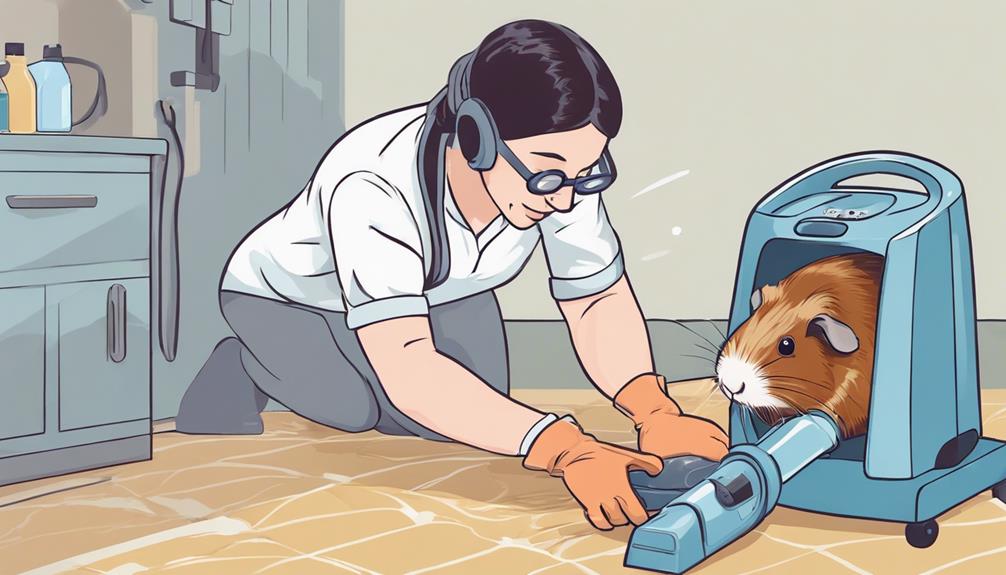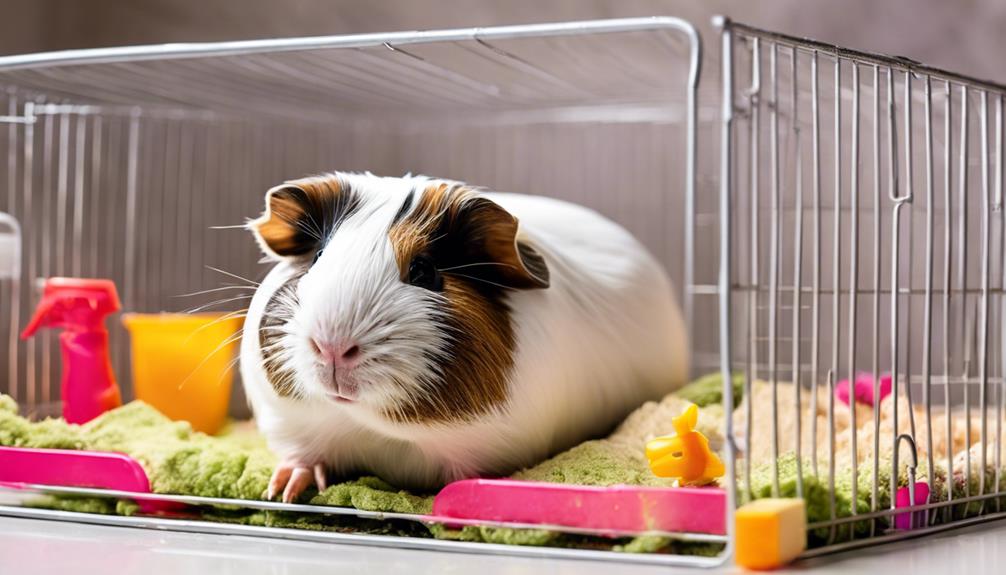What to Do When Your Guinea Pig Has Mites

Guinea pigs are susceptible to mites, which can cause discomfort and health issues if left untreated. To keep your furry friend healthy, it's important to take preventive measures and promptly address any signs of a mite infestation. Regularly check your guinea pig for symptoms such as hair loss, scaly skin, and excessive scratching. If you suspect mites, consult a veterinarian for a proper diagnosis and treatment plan. Additionally, maintaining good hygiene in your guinea pig's living environment, providing a balanced diet, and minimizing stress can help prevent mite infestations. By staying vigilant and proactive, you can ensure your guinea pig stays happy and healthy.
Remember, early detection and treatment are key to managing mites in guinea pigs effectively. Regular veterinary check-ups and proper hygiene practices are essential in preventing and controlling mite infestations. Be attentive to your guinea pig's behavior and appearance, and seek professional advice if you notice any concerning symptoms. With proper care and attention, you can help your guinea pig thrive and enjoy a mite-free life.
Key Takeaways
- Swiftly consult a veterinarian for accurate diagnosis and treatment.
- Implement proper grooming and hygiene practices to prevent mites.
- Administer prescribed medications diligently for effective mite eradication.
- Maintain a clean living environment and monitor recovery progress closely.
Understanding Mites in Guinea Pigs
Mites are tiny parasites that can cause discomfort and health issues for guinea pigs. These microscopic pests can lead to itching, hair loss, and skin irritation in our furry friends. To guarantee the well-being of guinea pigs, it's essential to take preventative measures to control mites effectively.
Preventative measures play an important role in keeping mites at bay. Regularly cleaning the guinea pig's living environment, including bedding and cage, is essential. Using veterinarian-approved mite prevention products can also help in parasite control. Additionally, making sure that the guinea pig has a balanced diet and proper grooming can boost their immune system, making them less susceptible to mite infestations.
Recognizing Symptoms of Mites
Guinea pigs affected by mites often exhibit visible skin irritation, noticeable through redness or scabs on their skin. Owners may observe a significant increase in scratching behavior as the guinea pig tries to alleviate the discomfort caused by the mites.
Additionally, patchy fur loss can be a telltale sign that mites are present, indicating the need for prompt veterinary attention to address the issue.
Visible Skin Irritation
When dealing with guinea pig mites, recognizing the visible skin irritation that may indicate their presence is vital. To identify these signs, caregivers should look out for:
- Hair Loss: Patchy or uneven hair loss, especially around the ears, back, and hindquarters, can be a common indicator of mite infestation.
- Redness and Inflammation: Guinea pigs may exhibit red, inflamed skin, particularly in areas where mites have burrowed.
- Crusty Skin or Scabs: Presence of crusty skin, scabs, or small bumps can suggest mite activity and the need for prompt action.
Early detection of these symptoms is important for timely skin care and irritation relief for the affected guinea pig.
Excessive Scratching Behavior
Recognizing guinea pig mites often involves observing the pet's behavior, particularly noting any excessive scratching that may signal an underlying issue. Itchy guinea pigs may scratch themselves persistently, often leading to skin irritation and discomfort. Owners should pay close attention to their guinea pig's grooming habits; excessive grooming, especially focused on specific areas, can also indicate mite infestation.
If a guinea pig is spending an unusual amount of time scratching or excessively grooming, it's essential to investigate further for potential mite presence. Prompt identification and treatment of mites are critical to assure the well-being of the guinea pig and prevent the infestation from spreading. If these symptoms persist, consulting a veterinarian for proper diagnosis and treatment is recommended.
Patchy Fur Loss
Patchy fur loss can be a significant indicator of mite infestation in guinea pigs. When observing your guinea pig for signs of mites, pay close attention to any areas where the fur appears thin or patchy. Recognizing these symptoms early is important for prompt treatment.
To address patchy fur loss effectively, consider the following:
- Fur care and prevention: Regular grooming can help detect mites early and prevent infestations. Brushing your guinea pig's fur gently can also improve circulation and promote a healthy coat.
- Nutritional support: Make sure your guinea pig's diet is rich in essential nutrients to support overall health and fur quality. Consult with a veterinarian to determine the best diet for your pet.
- Grooming routine: Establish a consistent grooming routine to maintain your guinea pig's fur and overall well-being. Regular grooming sessions provide an opportunity to check for any changes in your pet's coat.
Consulting a Veterinarian
Seeking professional guidance from a knowledgeable veterinarian is important when dealing with guinea pig mites. A veterinarian can provide essential insights into preventative measures to maintain overall guinea pig health. They're equipped to offer advice on parasite control strategies and veterinary care tailored to the specific needs of your pet.
When consulting a veterinarian about guinea pig mites, it's essential to provide detailed information about your pet's symptoms and living conditions. This background can aid the vet in making an accurate diagnosis and recommending appropriate treatment options. Additionally, veterinarians can conduct skin scrapings or other diagnostic tests to confirm the presence of mites and determine the best course of action.
Treatment Options Available

When facing guinea pig mites, owners have several treatment options available. Medications prescribed by a veterinarian can effectively eliminate mites, while natural remedies like apple cider vinegar baths or coconut oil can also aid in mite removal.
It's important to consult with a professional to determine the best course of action for treating guinea pig mites.
Medication for Mite Removal
To effectively eliminate mites from guinea pigs, a variety of medication options are available for treatment. When dealing with mites in guinea pigs, it's important to use the right medication to guarantee the health and well-being of your furry friend. Here are some common medications for mite removal:
- Ivermectin: This medication is often prescribed by veterinarians to treat mites in guinea pigs. It can be administered orally, topically, or through injections.
- Selamectin: Another effective medication for mite removal in guinea pigs, Selamectin is usually applied topically to the skin once a month.
- Revolution: Revolution is a topical medication that can help eliminate mites in guinea pigs when applied as directed by a veterinarian.
Natural Remedies for Mites
When considering alternatives to medication for treating mites in guinea pigs, exploring natural remedies can provide a vital yet effective approach to addressing the issue. Herbal treatments like chamomile, calendula, and lavender have soothing properties that can help alleviate discomfort caused by mites.
Essential oils such as neem oil, tea tree oil, and clove oil are known for their antiparasitic and antimicrobial properties, which can aid in combating mites. When using essential oils, it's essential to dilute them properly to avoid skin irritation.
Additionally, maintaining a clean living environment for the guinea pig, including regularly washing bedding and ensuring proper ventilation, can help prevent mites from recurring. These natural remedies offer a holistic approach to managing mites in guinea pigs, promoting their well-being without harsh chemicals.
Medication and Application Process
Administering medication for guinea pig mites involves a precise and careful application process to guarantee effective treatment. To properly medicate a guinea pig for mites, follow these essential steps:
- Application Technique: When applying medication, make sure to cover the affected areas thoroughly. Gently part the fur to expose the skin where mites typically reside. Apply the prescribed amount of medication directly to the skin, avoiding the eyes, nose, and mouth.
- Dosage Adjustment: It's important to administer the correct dosage as prescribed by the veterinarian. Never adjust the dosage without consulting a professional, as improper dosing can lead to treatment failure or adverse effects on your guinea pig's health.
- Side Effects and Follow-Up Care: Monitor your guinea pig for any adverse reactions to the medication, such as increased itching or skin irritation. Additionally, follow up with the veterinarian as scheduled to ensure the mites are effectively eradicated and to address any concerns promptly.
Environmental Cleaning and Care

Maintaining a clean and hygienic environment is essential for effectively managing guinea pig mites. Regular cage hygiene is important in preventing mites from spreading and recurring. It's recommended to clean the cage thoroughly at least once a week, removing any bedding that may harbor mites or their eggs. Opt for bedding choices like paper-based or fleece bedding, as they're less likely to harbor mites compared to wood shavings. When treating a guinea pig for mites, it's important to replace all bedding and clean the cage with a mild soap or pet-safe disinfectant to eliminate any remaining mites.
Additionally, washing and disinfecting any toys or accessories in the cage can help prevent mites from reinfesting your pet. Regularly washing your guinea pig's bedding, accessories, and cage can significantly reduce the risk of mites returning. By maintaining a clean environment and making suitable bedding choices, you can help protect your guinea pig from mites and provide them with a safe and comfortable living space.
Monitoring Recovery Progress
To confirm the effective management of guinea pig mites, monitoring the recovery progress is a key aspect that pet owners should focus on after implementing proper environmental cleaning and care practices. This step is vital in making sure that the guinea pig is on the path to full health and well-being. Here are some essential points to ponder during the monitoring process:
- Recovery Milestones: Keep track of specific milestones in your guinea pig's recovery journey, such as reduced scratching, improved coat condition, and overall increased activity levels. These milestones can indicate progress and help gauge the effectiveness of the treatment.
- Monitoring Techniques: Regularly inspect your guinea pig for any signs of mites or skin irritation. Additionally, observe their behavior and appetite to ensure they're responding positively to the treatment.
- Dietary Support and Exercise Regimen: Provide your guinea pig with a balanced diet rich in nutrients to support their immune system during the recovery process. Encourage gentle exercise to promote circulation and overall well-being.
Preventing Future Mite Infestations

To prevent future mite infestations in guinea pigs, consistently maintaining a clean living environment is essential. Preventive measures such as regular cage cleanings, washing and replacing bedding frequently, and ensuring proper ventilation can help keep mites at bay. Additionally, implementing long-term solutions like providing a balanced diet rich in Vitamin C to boost the guinea pig's immune system can aid in preventing mite infestations.
Regular health check-ups with a veterinarian are also vital in catching any potential mite problems early on. These check-ups can help identify any signs of mites before they become a full-blown infestation, allowing for prompt treatment and prevention of spread to other pets.
Frequently Asked Questions
Can My Other Pets, Such as Cats or Dogs, Get Mites From My Guinea Pig?
Pets like cats or dogs can contract mites from a guinea pig, but it's rare. Preventative measures include regular vet check-ups, keeping living areas clean, and avoiding direct contact between the animals. If needed, prompt veterinary care and treatment options are available.
Are There Any Natural Remedies or Home Remedies That Can Help Treat Mites in Guinea Pigs?
When guinea pigs have mites, using herbal treatments like baths with essential oils and supplements can help. These natural remedies can soothe and heal the skin, providing relief for the guinea pig.
How Long Does It Typically Take for a Guinea Pig to Fully Recover From a Mite Infestation?
Recovery timeline for a mite infestation in guinea pigs varies but typically takes a few weeks. Common symptoms include itching, hair loss, and skin irritation. Proper treatment and care are essential for a full recovery.
Can I Still Handle My Guinea Pig While They Are Undergoing Treatment for Mites?
While treating mites, it is crucial to limit handling to prevent stress and aid recovery. Bonding time can involve talking softly, offering treats, and gentle petting to maintain communication. Following proper handling precautions guarantees the guinea pig's well-being.
Are There Any Specific Dietary Changes I Should Make to Help My Guinea Pig Recover From Mites?
To aid recovery from mites, guarantee your guinea pig receives dietary supplements and vitamin-rich foods. These can support their immune system and overall health. Consult a vet for specific recommendations tailored to your pet's needs.











